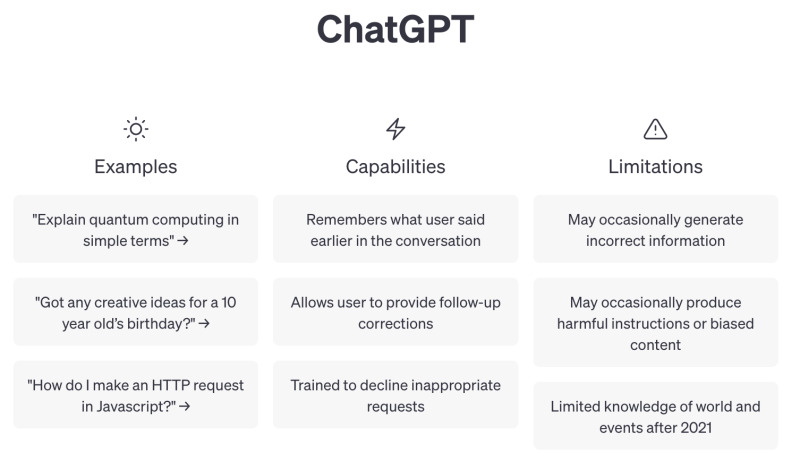AI-Generated Content: How ChatGPT Can Support Writing for Your Website
AI is emerging as one of the most powerful change agents in higher education. While AI is presenting unprecedented academic, ethical, and legal challenges in the classroom, it has the potential to completely reshape how we create content for the web.
ChatGPT
There are a number of AI applications available for free on the internet, but the most sophisticated and publicized tool is ChatGPT.
ChatGPT is a conversational chatbot powered by OpenAI. It can generate informative copy in response to a wide range of queries in a matter of seconds, and it’s already had far-reaching effects.
AI makes it difficult to recognize what is real and what is created by bots. It’s an existential threat that higher education will be facing for the unforeseeable future.
For some, it sounds too good to be true. A bot that does all the writing for me? Yes, please! To others, it is a frightening unknown that has the potential to cause harm — a way to cheat the system.
The reality is that ChatGPT is a tool, and like any tool it is designed to assist your work. It does not replace human thoughts; it supports our efforts.
In her article, “Reflecting on ChatGPT,” author Carrie Phillips, Chief Communications and Marketing Officer at University of Arkansas at Little Rock, notes the promise of the technology while offering three wise best practices:
- AI is a tool, not a solution.
- It doesn’t eliminate the need for strategy to guide the copy.
- It should be used sparingly.

Keep in mind that copy generated by tools like ChatGPT is usually technically fine in terms of grammar, syntax, and spelling. However, it is extremely generic, lacks an authentic voice, and is often repetitive. Sometimes it assembles the right pieces of information in the wrong order or context. Sometimes it is perfectly acceptable. It’s a gamble.
How to use ChatGPT
If it’s so riddled with issues, should you even try to use ChatGPT? Yes, you should. It is a useful tool that can aid in the writing process and can be integrated into our workflows. Here’s how.
Generating ideas
When facing writer's block or seeking inspiration, you can interact with ChatGPT to brainstorm ideas. Ask questions, explore different angles, or request suggestions on topics, headlines, or content structure.
Outlining and structuring
ChatGPT can assist in organizing thoughts and creating a well-structured outline for an article or blog post. You can discuss the main points and subtopics with ChatGPT, refining the structure before diving into the actual writing.
Drafting and editing
You can collaborate with ChatGPT during the drafting process. Provide partial sentences or prompts and ask ChatGPT to complete them, helping to generate content faster. Additionally, you can seek assistance from ChatGPT to refine and polish drafts by asking for suggestions, improvements, or alternative wording.
Fact-checking and research
ChatGPT can help with fact-checking and basic research. Ask specific questions, request definitions, or inquire about relevant statistics or data to ensure accuracy in your content.
Creating engaging introductions or headlines
You can work with ChatGPT to generate attention-grabbing introductions or compelling headlines. By experimenting with different variations and seeking feedback from ChatGPT, you can refine opening statements to captivate your audience.
Language polishing
ChatGPT can be used as a language tool to improve grammar, syntax, and vocabulary choices. Ask ChatGPT to review your content, identify errors or awkward phrasings, and propose alternatives for smoother, more coherent writing.
Remember, while ChatGPT can be a valuable tool, it's essential for you to review and validate the output it generates. And while it can assist you in all the ways stated above, there is no AI that can truly develop an effective content strategy.
Quality above all
Content is more than just information. The creation of high-quality content involves various elements that interplay, including brand identity, target audience, objectives, search engine optimization (SEO), and readability.
Although AI can serve as a valuable tool in developing quality content, its application requires careful and judicious handling. Ultimately, it is you — the writer— who determines whether the content successfully accomplishes its purpose.

